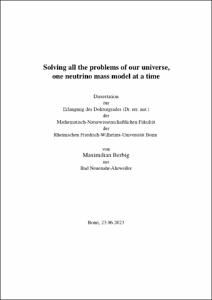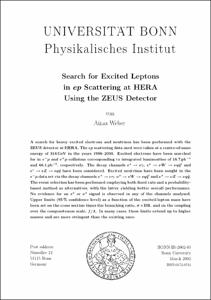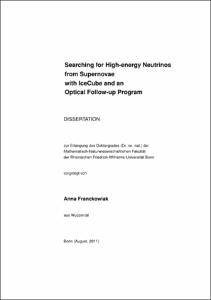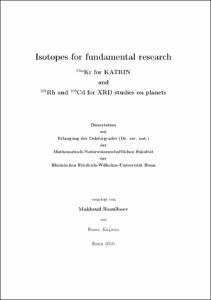Berbig, Maximilian: Solving all the problems of our universe, one neutrino mass model at a time. - Bonn, 2023. - Dissertation, Rheinische Friedrich-Wilhelms-Universität Bonn.
Online-Ausgabe in bonndoc: https://nbn-resolving.org/urn:nbn:de:hbz:5-72782
Online-Ausgabe in bonndoc: https://nbn-resolving.org/urn:nbn:de:hbz:5-72782
@phdthesis{handle:20.500.11811/11167,
urn: https://nbn-resolving.org/urn:nbn:de:hbz:5-72782,
doi: https://doi.org/10.48565/bonndoc-172,
author = {{Maximilian Berbig}},
title = {Solving all the problems of our universe, one neutrino mass model at a time},
school = {Rheinische Friedrich-Wilhelms-Universität Bonn},
year = 2023,
month = dec,
note = {The masses and mixing in the neutrino sector can not be explained by the Standard Model (SM) of particle physics and might be a harbinger for new degrees of freedom at energies scales far above or comparable to the electroweak scale. This thesis tries to find correlations between the associated models and the many unresolved issues in modern cosmology: The work covered in the first part tries to address the tension in the determination of the Hubble constant, which differs depending on whether it is extracted from cosmic microwave background data or local measurements using Cepheid variable stars as standard candles. We discuss a particle physics model realizing strong neutrino self-interactions that delay the neutrino free streaming before recombination that also generates a large amount of dark radiation from the equilibration of an entire dark sector. In the following we chapter we try to address the nature of dark matter in the form of a keV-scale neutrino, which is sterile under the SM gauge interactions, but couples to an abelian gauged B-L symmetry. We demonstrate that both the light neutrino and heavier dark matter mass can arise vial loop diagrams involving the same scalar sector. Dark matter and dark radiation in the form of right handed neutrinos are produced via out- of-equilibrium gauge mediated scatterings from the SM fermions. The part of this thesis devoted to the “S.M.A.S.H.E.D.” model extends a previous model known as SMASH (Standard Model Axion Seesaw Higgs Inflation), which was able to explain inflation, QCD axion dark matter, neutrino masses and the stability of the electroweak vacuum, to incorporate Dirac neutrinos. We generate a neutrino masses via a tree-level dimension six operator and showcase how the associated fermions lead to novel features in the context of Dirac Leptogenesis. This idea is followed by chapter, where the SM fermion and gauge sector receive a copy in the form of a so called mirror sector. We connect the neutrinos to their mirror counterparts via a bidoublet Higgs field. An exchange symmetry between the two sectors can solve the strong CP problem and we discuss the associated cosmology. Next we focus on the influence of very long lived right handed neutrinos (RHN) in the basic Type I Majorana Seesaw mechanism on the tensor modes predicted by cosmic inflation. We are able to show that the successful generation of the observed baryon asymmetry from Leptogenesis would lead to a damping of the primordial gravitational waves at frequencies above 0.1 Hz. The last chapter of this thesis deals with the entire class of Dirac Seesaw models: All Dirac Seesaws come with a Pseudo- Nambu-Goldstone-boson that we call the Diraxion, which can allow for a simultaneous explanation of the observed baryon asymmetry and the dark matter relic abundance. This scenario can be tested via isocurvature fluctuations, improved dark radiation limits, cosmic neutrino background searches and the dynamics of an associated GeV-scale scalar called the Saxion.},
url = {https://hdl.handle.net/20.500.11811/11167}
}
urn: https://nbn-resolving.org/urn:nbn:de:hbz:5-72782,
doi: https://doi.org/10.48565/bonndoc-172,
author = {{Maximilian Berbig}},
title = {Solving all the problems of our universe, one neutrino mass model at a time},
school = {Rheinische Friedrich-Wilhelms-Universität Bonn},
year = 2023,
month = dec,
note = {The masses and mixing in the neutrino sector can not be explained by the Standard Model (SM) of particle physics and might be a harbinger for new degrees of freedom at energies scales far above or comparable to the electroweak scale. This thesis tries to find correlations between the associated models and the many unresolved issues in modern cosmology: The work covered in the first part tries to address the tension in the determination of the Hubble constant, which differs depending on whether it is extracted from cosmic microwave background data or local measurements using Cepheid variable stars as standard candles. We discuss a particle physics model realizing strong neutrino self-interactions that delay the neutrino free streaming before recombination that also generates a large amount of dark radiation from the equilibration of an entire dark sector. In the following we chapter we try to address the nature of dark matter in the form of a keV-scale neutrino, which is sterile under the SM gauge interactions, but couples to an abelian gauged B-L symmetry. We demonstrate that both the light neutrino and heavier dark matter mass can arise vial loop diagrams involving the same scalar sector. Dark matter and dark radiation in the form of right handed neutrinos are produced via out- of-equilibrium gauge mediated scatterings from the SM fermions. The part of this thesis devoted to the “S.M.A.S.H.E.D.” model extends a previous model known as SMASH (Standard Model Axion Seesaw Higgs Inflation), which was able to explain inflation, QCD axion dark matter, neutrino masses and the stability of the electroweak vacuum, to incorporate Dirac neutrinos. We generate a neutrino masses via a tree-level dimension six operator and showcase how the associated fermions lead to novel features in the context of Dirac Leptogenesis. This idea is followed by chapter, where the SM fermion and gauge sector receive a copy in the form of a so called mirror sector. We connect the neutrinos to their mirror counterparts via a bidoublet Higgs field. An exchange symmetry between the two sectors can solve the strong CP problem and we discuss the associated cosmology. Next we focus on the influence of very long lived right handed neutrinos (RHN) in the basic Type I Majorana Seesaw mechanism on the tensor modes predicted by cosmic inflation. We are able to show that the successful generation of the observed baryon asymmetry from Leptogenesis would lead to a damping of the primordial gravitational waves at frequencies above 0.1 Hz. The last chapter of this thesis deals with the entire class of Dirac Seesaw models: All Dirac Seesaws come with a Pseudo- Nambu-Goldstone-boson that we call the Diraxion, which can allow for a simultaneous explanation of the observed baryon asymmetry and the dark matter relic abundance. This scenario can be tested via isocurvature fluctuations, improved dark radiation limits, cosmic neutrino background searches and the dynamics of an associated GeV-scale scalar called the Saxion.},
url = {https://hdl.handle.net/20.500.11811/11167}
}









